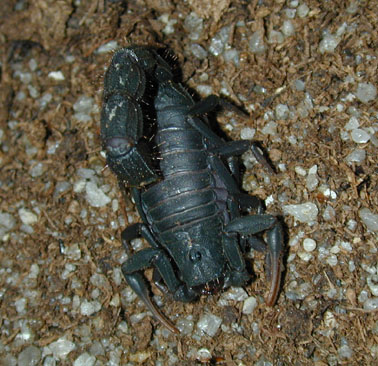Parabuthus
transvaalicus
(Purcell,
1899)
|
|

|

|
Common names:
This species is sometime known as "The
South African Fattail Scorpion".
Distribution:
Africa (Botswana, Mozambique, South Africa, Zimbabwe).
Habitat:
Hot and dry deserts and scrublands, but also in semi-arid
regions. This species hide in burrows, under stones, logs
etc.
Venom:
Medical data indicate that this species has a
strong venom and is medical significant. In a study in
Zimbabwe, 63 % of the stings of this species resulted in
intense pain only. 27 % of the stings resulted in minor
systematic envenomation (hypersalivation, sweating and
subjective neurological complaints). Severe scorpionism
was seen in 10 % of the cases (neuromuscular symptoms
with significant parasympathetic nervous system and
cardiac involvment). Fatality rate was 0.3 % with deaths
in children below 10 years and adults above 50 years. The
cadiac involvment in P. transvaalicus
envenomations differ from general buthid scorpionisms.
Use of species specific antivenom seem to have a positive
therapeutic effect.
LD 50 value for this species is reported to be 4.25
mg/kg. Due to it size, this scorpion can inject very
large amounts of venom. NB! This species is able to
squirt venom up to one meter away, and venom in the eyes
can be very dangerous. Safty glasses is reccomended when
dealing with this species.
The medical significance of this species has been
discussed. The Zimbabwe study indicates that P.
transvaalicus should be treated as a dangerous
species with a potential life-treatning venom.
Selected litterature:
Bergman, N.J. (1997). Clinical description of Parabuthus
transvaalicus scorpionism in Zimbabwe. Toxicon, 35
(5), pp. 759-771.
Gaban, D. (1997). On: Parabuthus transvaalicus
(Purcell). Forum American Tarantula Society, 6 (5), pp.
157-158.
Newlands, G. (1974). The venom-squirting ability of Parabuthus
scorpions (Arachnida:Buthidae). South African Journal of
Medical Sciences 39: 175-178.
Saunders, C. R. (1990). "Beware of the scorpion
Parabuthus." Centr. African J. Med. 36(4): 114-115.
On the Internet:
Gifttier
Informationsdienst Parabuthus spp.
Parabuthus antivenom information
Abstract of an article about Parabuthus venom i S-Africa.
General:
This spcies is one of the largest members of the buthid
family, and can be up to 15 cm long (8.5- 15 cm). This
species is blackish/brown (some colorvariations are
possible), with redbrown pincers. Pedipals and legs are
lighter in color. A powerful cauda with numerous redish
hairs. Small, slender pincers. No subacular tooth on
telson.
This species is reccorded in pet collections, both in
US and Europe. This species is dangerous, and should only
be kept by researchers and experienced keepers. No
current research on the species is known.
Right Parabuthus transvaalicus
(juvenile) photo by Jan Ove Rein (C)
Left Parabuthus transvaalicus (subadult)
photo by Jan Ove Rein (C)
|